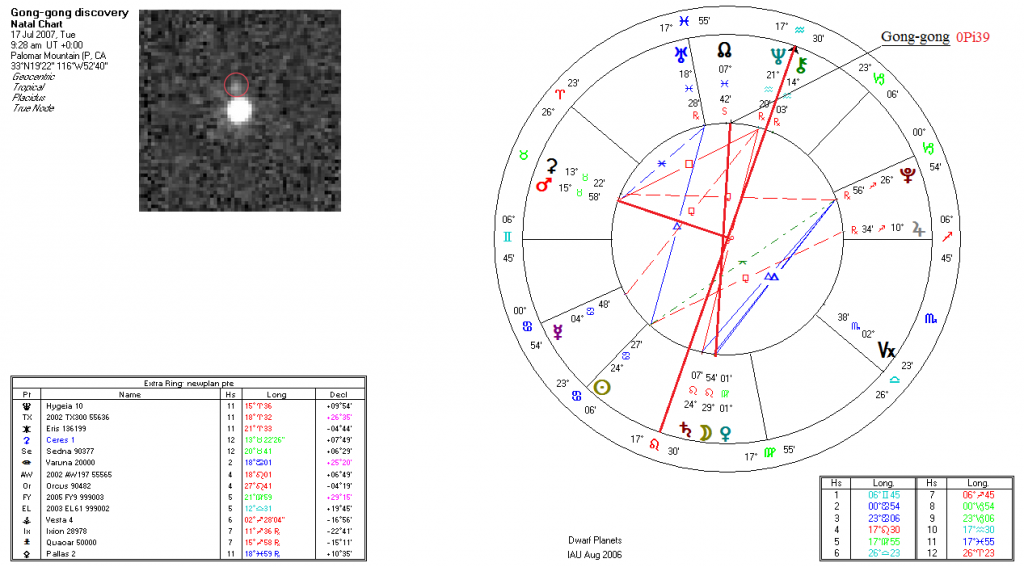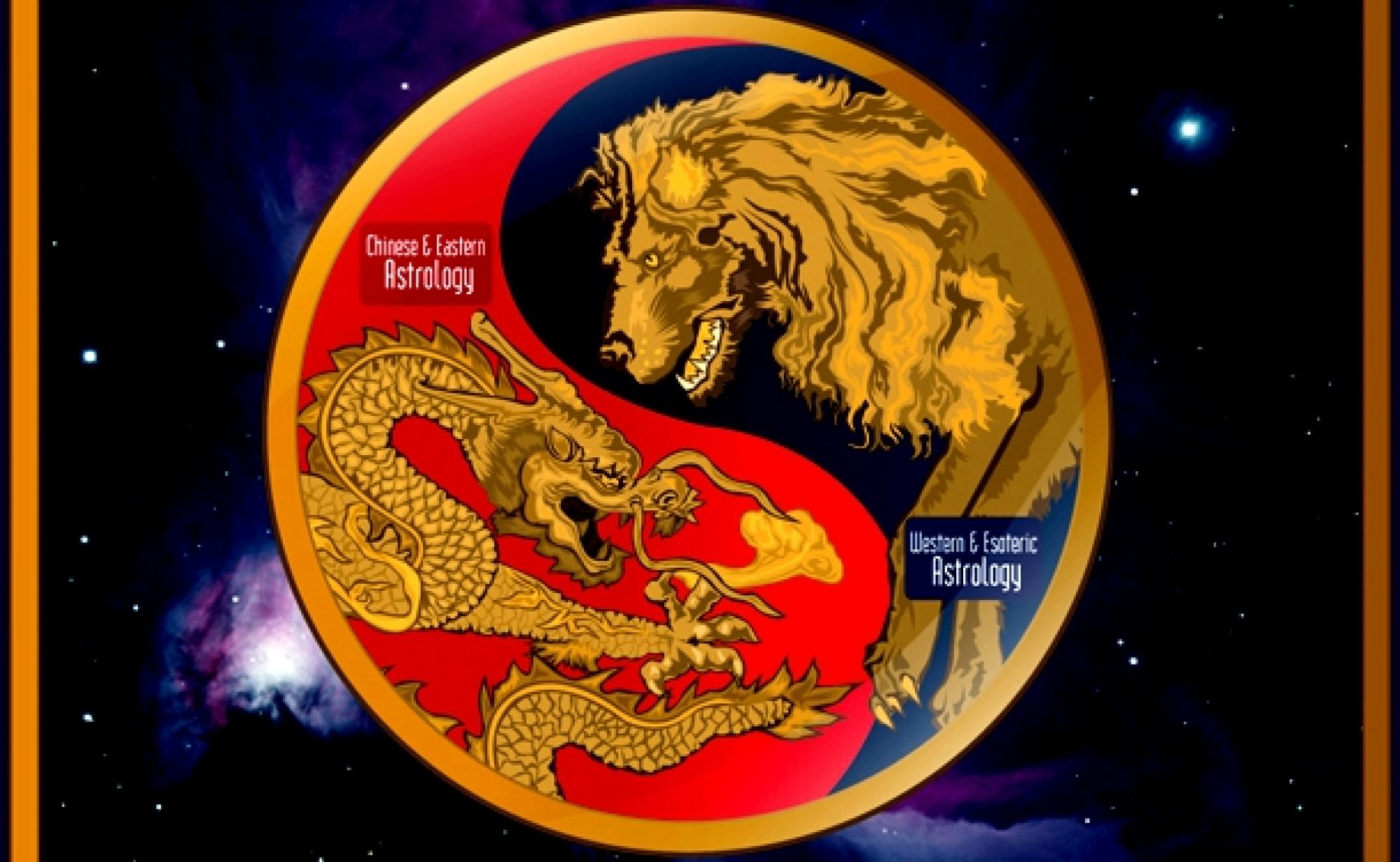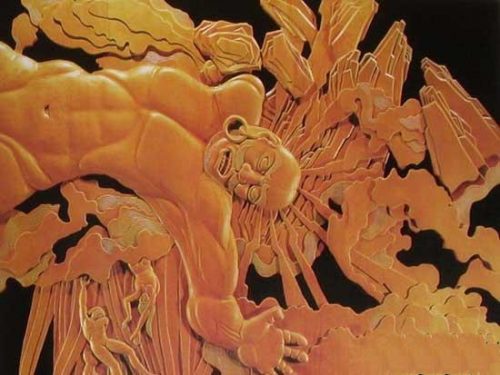We are about to receive another named planet into the astrological fold. It was discovered in 2007 and given the provisional name 2007OR10, originally nicknamed ‘Snow White’. Its new name will be Gong-gong, a water spirit, or demon, in ancient China. We will get to the mythology of our newest member in a bit. The discovery chart is below (bigger):

Gong-gong was discovered on 17 July 2007 at Palomar Observatory by Megan Schwamb, Michael Brown, and David Rabinowitz. Up until now it has been the largest dwarf planet without a name. In 2019 the discoverers hosted an online naming competition (archived) for ‘Snow White’. From the three names offered – Gong-gong, Holle and Vili – Gong-gong won out. I participated, and am happy to say that I went with Gong-gong. That being said, the planets name themselves. Enough people were impressed by the name that Gong-gong won.
Gong-gong is not pronounced as it is written. What we have is a Romanization from the Chinese pronunciation of Chinese, 共工 (Gònggōng) or 龔工 (Gōnggōng). The closest we would come if we are Westerners would be ‘gong kun’, with the emphasis on the first syllable. That perhaps goes to how its actions in horoscopes will be judged, too. It, along with other dwarf planets like Makemake, Haumea and Quaoar will have their names mispronounced, especially by English-speakers, for a long time to come. Then, too, this Gong-gong is not an Oriental dish prepared from sea snails.
The other names put up for adoption are of interest, but they will also go to show why Gong-gong was chosen, or we should say, impressed upon our consciousness. Starting with Holle, she is from the German, a.k.a. ‘Frau Holle’, ‘Mother Hulda’ and ‘Old Mother Frost’ – number 24 of Grimm brothers’ Children’s and Household Tales. She predated Christianity and was the goddess of spinning and weaving. From Wikipedia:
“Frau Holle resides somewhere above the earth, and the protagonists must go to her, paradoxically by diving into a spring. When she makes her bed, loose feathers are ‘stirred up’ and fall to earth as snow, and so this fairy tale is an origin myth as well. Comparison between Frau Holle and a weather or earth goddess is inevitable.”
She personifies good behavior and bad, and metes out the appropriate rewards for each.
As to Vili, this was a Norse god, one of the brothers of Odin, along with Vé. His name means ‘will’ (as in will-power). The three brothers represent the creation story:
“To the first human couple, Ask and Embla, Óðinn gave soul and life; Vili gave wit (intelligence) and sense of touch; and Vé gave countenance (appearance, facial expression), speech, hearing, and sight.”
They were equivalent to the Trinity in Christianity, though they predated Christianity. Odin is the best-known and was the most powerful of the gods, the head of yet another trinity, and the most occult.
And that brings us to Gong-gong. My own reason for choosing Gong-gong out of the three choices had little to do with my work with Chinese astrology. It came out of work that I had done five years before in researching these little planets, and we’ll get to why in a bit. Gong-gong’s mythology is as follows:
“Gong-gong is a character in ancient Chinese legends and is known to be the God of floods. According to the legends, Gong-gong had red hair, a human face and a snake’s body. He was thought to have a black dragon as his ride and he was thought to be a descendant of the Yan (Flame) Emperor. It was said that Gong-gong was ambitious, cruel and vicious though stupid at the same time.
The most famous legend concerning Gong-gong is the story of Buzhou Mountain. At a certain time in ancient China, the throne of heaven was passed on to Zhuanxu, who did not care about the mortals and also treated his fellow Gods badly. As a result, Gong-gong, along with some other Gods, formed a rebellion party in attempt to usurp the throne. A long and heated war began and Gong-gong’s party began losing more and more warriors. At the end, Gong-gong was forced to the northwest end of the world, next to Buzhou Mountain by the opposite party. There was nothing else that Gong-gong could do except to accept his failure.
Angry that he has lost his claim to the throne in heaven, Gong-gong smashed his head against Buzhou Mountain in his rage. Buzhou Mountain was thought to be the pillar supporting the sky in the northwest direction and with the smash, the pillar was damaged and could not support the sky any more. As a result, the sky, together with the sun, the stars and the moon all started to tilt towards the northwest while the land started to tilt towards the southeast. Everything started to fall towards the sea, there was a great flood and people on land suffered greatly. The Goddess Nuwa took pity on the people and tried to mend the sky. Though she was unable to do it completely, the situation did get better, allowing people to continue to live on land. It was thought for this reason rivers in China flow towards the southeast, while the sun, the stars and the moon moves towards the northwest.
…there are some versions of the legend saying that instead of being a tyrant, Gong-gong was actually a good person and leader living in ancient China. It was said that he made major contributions in tending floods and water problems. Apparently, it was he who suggested filling the lowland areas up and building dams on those areas. Apart from tending floods, Gong-gong was also known to make major contributions to farming in China and it was said that he is the second most important figure in ancient Chinese farming, right after Shennong…”
There is another version of the myth where Gong-gong is depicted as a black dragon who, allied with a wicked nine-headed demon, Xiangliu, caused ruptures in the earth and unleashed terrible creatures from the underworld, floods and great destruction, killing countless people. This latter sounds very much like an Atlantean myth, with the war between the Brothers of the Dark Face and the Brothers of the Light, causing the sinking of the continent.
The common theme to both of Gong-gong’s myths is that he crashed his head into Buzhou Mountain in a fit of pique and desperation, causing the Earth to tilt on its axis, giving rise to the seasons and changing the courses of rivers, as well as the rotation of the Earth. In that respect he has similarities with Ceres, though he is a male god. He, too, represents turning points, but his turning points are more in the realm of mind, given his bashing of his head into a mountain.
Often we find at the time of discovery of planets that outer events coincide with the discovery and symbolism of those planets. Twelve hours after the discovery of Gong-gong there was a terrible airline crash in Brazil when a plane overran the runway on landing and killed everyone on board, as well as people in a nearby structure. There was also severe weather and flooding in the UK that summer. On the day there was also a 6.8 magnitude quake in Japan that damaged a nuclear power plant. And there were heavy floods in India in the two weeks preceding. Referring back to the discovery chart, we see that Gong-gong had just entered Pisces prior to its discovery, ruled by Neptune, god of the deep oceans.
But perhaps the most revealing part of the chart relates to the Sabian symbol at the degree of the Midheaven:
A man’s secret motives are being publicly unmasked (17 – 18 Aquarius)
We also find that Mars squares the Meridian axis and Mercury is on the ‘train wreck’ degree of Cancer. Its discovery roughly coincides with the period wherein the Great Recession really started to take hold with the subprime housing crisis in the US. Its entry into Pisces (2006) also roughly coincided with a growing pronounced concern with rising sea levels and climate change. Al Gore’s An Inconvenient Truth was released the year before. [For an ephemeris, go here, and enter 225088 for planet number.]
Let’s begin to unmask what this little planet actually represents to us, then. Physically, Gong-gong is located in the scattered disc, and it has an orbital period roughly equivalent to that of Eris at 551 years. Its inclination off the ecliptic is only 30.7°, though, which is about 15° less than that of Eris. However, the eccentricity of its orbit is slightly greater than that of Eris. It is approximately the same size as Haumea. It displays a 3:10 orbital resonance with Neptune, and it is currently located at the projected longitude of 4 Pisces 30 at its retrograde station, at a declination of roughly 12° south. It will be in the constellation of Aquarius until 2054. It will also be in the sign Pisces during that period, and through the remainder of this century. But those distinctions bring up a point of real interest.
Gong-gong passes through 24 of our current constellations – half of the original Ptolemaic 48 – Camelopardalis, Auriga, Lynx, Cancer, Leo, Sextans, Crater, Corvus, Hydra, Centaurus, Lupus, Norma, Ara, Telescopium, Sagittarius, Microscopium, Pisces Austrinus, Capricorn, Aquarius, Pisces, Pegasus, Andromeda, Pisces and Perseus. From that list you will notice that some of the zodiacal constellations are missing – Aries, Taurus, Gemini, Virgo, Libra and Scorpio – half of them. That has significance, too, which we won’t go into here. We could probably rightly say that Gong-gong has its own zodiac. Considering what we see from the zodiacal degrees, they are actually projections onto the ecliptic, and this brings up some rather interesting considerations.
Now, consider that the major planets (the planets from Mercury through Neptune) all transit through the twelve zodiacal constellations plus Ophiuchus (between the constellations Scorpius and Sagittarius). We won’t go into the nonsense about the 13th ‘sign’ here. Those same planets also sometimes graze through the top portions of Orion and Cetus, but we don’t count those in astrology. Perhaps we should. It is the dwarf planets that routinely transit through the non-zodiacal constellations. All told, they give us another view of the heavens and open new vistas to us. And, as it turns out, when the dwarf planets change constellations (not signs), they signal events. This brings us to why I chose Gong-gong out of the three names, but we can start with what it signals when it changes the normal zodiacal signs.
Consider the following dates and what followed quickly thereafter: 1938 (Aquarius), 1905 (Capricorn), 1886 (Sagittarius), 1871 (Scorpio), 1857 (Libra) and 1841 (Virgo). Immediately after it entered Aquarius, WWII essentially began in Europe, our biggest human disaster in modern history. Air power (Aquarius) became the prime strategic objective. In 1906 Mt. Vesuvius erupted and devastated Naples. There was also a typhoon in Hong Kong that killed 10,000. But more than that, it was a landmark year in physics, with seminal papers by Einstein, the Annus Mirabilis in physics. The first powered aircraft appeared around that time, too. The ‘00s of the last century were quite a decade. The very structure of matter (Capricorn) was discerned and humanity realized its first powered flight off the surface of the Earth (also Capricorn).
In 1886, Europeans began to colonize Africa (Sagittarius, foreign exploration and conquest). Krakatoa erupted in Indonesia the next year. But it also marked the patenting of the first automobile by Karl Benz (also Sagittarius), the first electric motor, the first modern welding machine, electric arc lamps and improved electric transformers. Power transmission became possible.
1871 marked the formation of the French Third Republic and the German Empire. The Reconstruction was underway in the US after the Civil War. In physics, thermodynamic entropy was finally defined. This has wide ramifications and refuted certain aspects of Newtonian physics. Essentially, this showed that heat was an energy, which had been believed before to be a particle that had mass. The Reconstruction was a very Scorpionic time in the US and kept the South and blacks backward for many decades after the war. The occult side of Scorpio showed through with the work in thermodynamics (Mars, fire and heat).
1857 saw the revolutionizing of the steel industry with the Bessemer converter going into production. This related to finding the correct balance (Libra) of materials and process to produce good steel in mass quantities. It gave a huge boost to the industrial revolution. The first Singer sewing machines (Venus, for families) appeared on the market. The first trans-Atlantic telegraph cables were laid. This was a revolution in communication.
In the early 1840s the Daguerreotype camera was introduced. Photography became widespread. The world then had ‘perfect’ capturing of images (Virgo). Hypnotism was first named in 1841. Anesthesia was used for the first time a year later, revolutionizing surgery (Virgo). Do we see a pattern emerging? The technologies and science that came when Gong-gong changed signs revolutionized the thinking and industry of the times. This is repeated but in finer detail, when we mark the changes in constellations.
Here are a few examples – the constellation, the date entered (approx.) the discoveries and the date of the discoveries:
- Centaurus (1868) Periodic Table of the Elements (1869)
- Lupus, the Wolf (1879) Statistical definition of entropy (1877)
- Norma, the Set-Square (1888) Michelson-Morely experiment (1887) Existence of electromagnetic waves proven (1888)
- Ara, the Altar (1894) Discovery of X-rays (1895) and radioactivity (1896)
- Telescopium (1905) Special relativity, Brownian motion, photoelectric effect
- Sagittarius (1923) Pauli Exclusion principle (1924)
- Microscopium (1935) Discovery of the neutron (1934) Idea of falsifiability (1934)
- Pisces Austrinus, the Southern Fish (1963) Quark model proposed (1964)
- Capricorn (1975) Quark model’s validity proven (1974) Voyager Program (1977)
We note that these are not exact dates, but correspond to a shift in consciousness over time.
Let’s tie all this together, then. Gong-gong, like Pluto, has the attributes of a serpent. He brings healing, but it is healing in the mental realm. Science and technology progress through concentrated effort, trial and error, resulting frustration when a result does not seem within reach – as in beating one’s head against the wall – and then a sudden flood of insight once the breakthrough comes. The same is true of meditative work, which is what science is, essentially. And as we can see, the more important actions of Gong-gong tend to be mental, rather than physical. When Gong-gong changes signs and constellations (both are valid), the pillars of prevailing thought are shaken or shattered, and the world view must then be adjusted to accommodate the new views. These new views, in their turn, then become the established pillars of human knowledge. The more physical manifestations tend to come through the signs rather than the constellations. It is for the preceding reasons that Gong-gong appears to be the proper name for this planet.
Transits of Gong-gong to planets in one’s own chart generally go slowly, as would be expected, and last up to seven years on average. The process is one of deep readjustment to one’s thinking, depending on the planets involved. Those transits also reflect collective influences on a person’s thought processes. And since it is a god of floods, those transits can also bring many tears along the way. Gong-gong appears to have a specific action on the astral body, purging and clarifying it through mental action, i.e., through sitting with oneself and examining one’s life. But at the end of the process, a new mental vista appears before the person and the astral nature is much clarified. Those transits also give one a greater sense of one’s place in society and one’s contribution to the same.
These are only preliminary results and much more research needs to be undertaken. But we welcome this newest member into the astrological lore. In one of the myths Gong-gong was said to be stupid, but from what we see here, what emerges from apparently ignorant actions is actually the road to truth and insight in the end and shows the promise of mental efforts well-directed and pointedly focused. And with his naming, a new page in astrological studies is opened – the study of the entire vault of the heavens, and not simply the twelve or so signs we normally consider. And then, we eventually need to consider the Chinese asterisms and individual stars he contacts in his travels. I may get around to it someday. Any other takers?
Featured pic from Ferrebeekeeper

